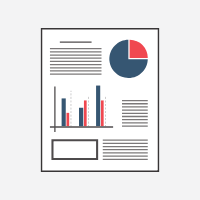Successfully using assets to generate sales growth is a key trait of strong companies. But how is it measured?
The answer is found by analyzing a company’s asset management ratios. Also known as, efficiency ratios or turnover ratios.
In today’s post we'll cover a few main points, including:
- The basics of asset management ratios,
- What they measure,
- Five key asset management ratios, and
- A list of asset management ratios and formulas.
By the end of this article you'll have everything you need to measure whether a company is successful at using its assets effectively.
What are Asset Management Ratios and What Do Asset Management Ratios Indicate?
Asset management ratios measure how effectively and efficiently a company is using its assets to produce sales and grow the business.
Strong companies use their assets to create additional cash flow and revenue for their business. This additional capital can then be reinvested back into operating activities to generate more growth. If a company has too much of their money tied up in assets, this can lead to shortfalls in operating cash flow.
You may be wondering:
I thought assets were a good thing? Those assets have value and they’ll get money eventually, so what’s the big deal if it takes a while?
Well, there could be a problem with this scenario. Higher assets could mean that the company isn’t generating revenue and cash flow from its resources. Slow turning assets can force a company to find other ways to pay for day-to-day operating expenses. This usually means raising additional capital, or taking on more debt.
Let's say you are analyzing a company and the first thing you look at is its current ratio. You notice that, wow, this company is on point! Highest current ratio you have ever seen.
And look at Accounts Receivable - it’s three times higher than you would have expected, nice!
Not so fast.
As a smart analyst, you know the importance of getting the complete picture. So you carry out your analysis and dive into all of the asset management ratios of the company.
Uh-oh, your view of the company starts changing.
Their accounts receivable turnover ratio is way lower than industry averages, and inventory is growing, but sales are decreasing!
Where did it go wrong?
The answer is:
Assets can be a key part of an awesome company. But it can be a problem if the management team isn’t turning those assets into operating cash flow!
Your goal is to invest in companies with strong assets that are ready to maximize cash flows and returns to investors.
What you don’t want to see is a company stacking up assets without any sales growth. This results in a high cash burn and low opportunities for growth.
Analyzing these ratios is a key step in effective financial ratio analysis and fundamental analysis.
5 Key Formulas for Measuring How Well a Company Manages Its Assets
There are five main ratios that measure how efficiently and effectively a company is managing its assets.
We’ll start by reviewing the accounts receivable turnover ratio.
1. Accounts Receivable Turnover (A/R Turnover)
The A/R turnover ratio measures how well a company is managing its accounts receivables. It also assesses whether the business has financially strong customers.
In general, the higher a company’s A/R turnover ratio, the better.
The accounts receivable turnover ratio is calculated by:
First, using a company’s balance sheet to calculate average receivables during the period.
Average Accounts Receivable Formula = (beginning A/R + ending A/R) / 2
+2017+Current+Assets.png)
Next, dividing the average receivables balance by net credit sales during the period.
A/R Turnover Formula = Net Credit Sales / Average Accounts Receivable
+2017+Net+Sales.png)
You can also use our A/R Turnover Calculator to calculate this ratio during your analysis.
2. Inventory Turnover
The inventory turnover ratio measures how well a company is managing its inventory. A high inventory turnover ratio means the company is producing and selling inventory at a fast rate. And the number of days inventory sits on the shelf is low - which is good news for investors!
The inventory turnover ratio is calculated by taking a company’s cost of sales (or cost of goods sold):

And dividing that by the company’s average inventory:
Average Inventory Formula = (beginning inventory + ending inventory) / 2

Inventory Turnover Ratio = Cost of Sales (COS) / Average Inventory
You can also use our Inventory Turnover Calculator to calculate this ratio during your analysis.
3. Working Capital Turnover Ratio
Alright, we have arrived at our third key ratio, the working capital turnover ratio.
To calculate the working capital turnover ratio, take net sales and divide that by average working capital during the period. In other words:
Working Capital Turnover Ratio = Net Annual Sales / Average Working Capital
Let's look at an example.
Apple’s working capital (current assets - current liabilities) was $27,831 and $27,863 for 2017 and 2016 (in millions). This calculates to an average working capital of $27,847.
Reported revenue was $229,234.
If we plug the reported numbers into the formula above, we end up with:
$229,234 / $27,847 = 8.23 Working Capital Turnover Ratio
Not bad!
This ratio measures how well a company utilizes its working capital to support their sales. Generally, the higher the working capital turnover ratio, the better a company can cash flow its own operations.
However…
Watch out for a working capital turnover ratio that is too high (I mean, really high). This could mean that the company doesn’t have enough working capital to support its sales growth.
This is rare and usually not a huge concern. But if you see very high working capital turnover ratios, usually over 70, it’s worth investigating further. There could be hidden trouble ahead if a company is burning through working capital that quickly.
A low working capital turnover ratio could mean there is a build up in key operating accounts. These accounts are typically accounts receivable and inventory. Build up in these accounts might indicate a company has excess inventory, or aged receivables that will eventually be written-off.
4. Fixed Asset Turnover Ratio
The fixed asset turnover ratio measures how well a company uses its fixed assets to generate revenue for the business.
A high fixed asset turnover ratio is a good indicator that management is making smart investments into fixed assets. More turns means those investments are paying off by generating revenue for the company.
Both positives in my book!
The fixed asset turnover ratio is calculated using data found on a company’s income statement and balance sheet.
First, use a company’s balance sheet to find the total fixed assets line item:

Next, locate net revenue on the company’s income statement, and insert the numbers into the formula below:
Fixed Asset Turnover Ratio = Net Revenue / Fixed Assets, Net
One thing to remember about the fixed asset turnover ratio:
The amount of fixed assets required for a company to be successful depends on the operations of a company.
For example:
An internet company would have a much different fixed asset requirement than a heavy machinery manufacturing company.
Comparing the internet company’s fixed asset turnover ratio to the manufacturing company wouldn’t provide much value.
5. Total Asset Turnover Ratio
The total asset turnover ratio measures how well a company uses all of its assets to generate revenue. A high asset turnover ratio indicates that a company is quickly and efficiently turning their assets into cash for the business.
Calculating a company’s total assets turnover ratio is simple.
First find the company’s revenue during the period.
Next, divide revenue by the company’s average total assets.
Asset Turnover Ratio = Revenues / Average Total Assets
The formula for calculating average total assets used in the above formula is:
Average Inventory Formula = (beginning inventory + ending inventory) / 2
It’s important to keep a few things in mind when analyzing a company’s asset turnover ratio:
- This ratio can fluctuate depending on the nature of the businesses operations and the industry the company operates in; and
- Because of this, finding the right benchmark to interpret the asset turnover ratio is very important.
For example, retail stores generally have higher asset turnover ratios. This is because the business doesn’t require a significant investment in assets to operate. On a very small scale, think about if you were to start a small boutique clothing shop.
All you would need was enough inventory to stock the shelves. You could then lease a store front, and away you go. The only significant asset required would be the inventory.
But think about this from an industry on the other end of the spectrum. Let’s say a wireless cell phone provider.
A wireless cell phone provider requires a lot of assets to operate and generate revenue. Think about the amount of equipment, cabling, and hardware it takes for AT&T to build out their network.
None of us could even think about starting a competitor of AT&T. The investment it would require to build out the assets would be huge.
Check out the example below:
| (in millions) | Wal-Mart Stores | AT&T Inc. |
| Beginning Assets | 199,825 | 403,821 |
| Ending Assets | 204,522 | 444,097 |
| Average Total Assets | 202,174 | 423,959 |
| Revenue | 500,343 | 160,546 |
| Asset Turnover Ratio | 2.47 | 0.38 |
As you can see, Wal-Mart’s asset turnover ratio is much higher than AT&T’s.
Does that mean that Wal-Mart is a better investment than AT&T?
Not necessarily.
It would require additional analysis and insight into how each company’s ratios are performing over time. It would also depend on how each company compares to their direct competitors.
List of Key Asset Management Ratios and The Formulas You Need to Calculate Them
We’ve summarized the key remaining asset management ratios below:
| Ratios | Formulas |
|---|---|
| Asset Turnover | Revenues / Average Total Assets |
| Inventory Turnover | Cost of Goods Sold / Average Inventory |
| Days Sales In Inventory | 365 days / Inventory Turnover Ratio |
| Accounts Receivable Turnover | Net Credit Sales / Average Accounts Receivable |
| Accounts Payable Turnover | Total Purchases / Average Accounts Payable |
| Capacity Utilization | Actual Output / Potential Output x 100 |
| Cash Conversion Cycle | Days Inventory Outstanding + Days Sales Outstanding - Days Payable Outstanding |
| Defensive Interval | Current Assets / Daily Operating Expenses |
| Fixed Asset Turnover | Sales Revenue / Total Fixed Assets, Net |
| Working Capital Turnover | Net Annual Sales / Average Working Capital |
The Power of Asset Management Ratios in Your Stock Analysis
Asset management ratios are a key piece of the overall Financial Analysis puzzle.
It doesn’t bode well for a company if they aren’t managing their assets effectively. You want to invest in stocks that provide a higher return and lower risk. Company’s with a low return on their assets don’t exactly fit this criteria.
Remember, assets aren’t really assets if they don’t generate a return for the company!
So, dig deep on a company’s efficiency ratios before you invest to avoid surprises down the road.
If you're interested in finding stocks with optimal asset management and turnover ratios, look no further.
Use our Stock Screener to find undervalued companies with strong financial ratios!








